At the early stages of life, your child may be susceptible to various bacterial & viral infections which could affect their vital organs and bodily functions. Some of these pathogens cause mild complications while others may be terminal if left untreated. Our bodies however, are perfectly capable of creating antibodies to counter the insurgence of foreign organisms. Despite that, a child’s fragile and relatively underdeveloped immune system may not be able to produce enough of these antibodies on time to ail the infection – some infections work more rapidly than others. As a result, they may have to endure prolonged suffering of symptoms which, quite sadly could end in permanent disability or death. Enter vaccines – a product containing a weaker version of the infective agent or antigens, which helps your child to develop immunity without the initial sickness.
What are Vaccines and how do they work?
Safe, Proven and Effective
Often dubbed as one of the greatest tools in the public health arsenal, vaccines offer promise of protection for your child against a variety of infectious diseases. Many comprehensive studies have been and continue to be done to test for the safety and efficacy of vaccines. Its research and development is often performed under strict and current rules and regulations set forth and monitored by reputable health authorities (i.e. Center for Disease Control and Prevention [CDC] and US Food and Drug Administration [FDA]). It takes years, thousands of volunteers and decades of surveillance to ensure that each vaccine, whether it be compulsory or optional, is safe and effective for your child.
The phases of clinical development of any vaccine are:
- Phase I – small groups of people given the trial vaccine.
- Phase II – expanded group to include people with characteristics similar to those for whom the vaccine is intended.
- Phase III – given to thousands of people and tested for efficacy and safety.
- Phase IV – ongoing studies and monitoring after the vaccine is approved and licensed.
*check out CDC’s ‘The Journey of Your Child’s Vaccine’ for more details.*
Granted that there are a few cases of adverse vaccine side-effects, but they are mild, isolated, short-lived and most of the time, coincidental. Compare that to the overwhelming health benefits of immunisation which may include (but not limited to):
- Prevention of possibly fatal infectious diseases.
- Prevention of disease symptoms which may cause unnecessary pain and discomfort.
- Prevention against outbreaks and epidemics.
- Reduced health cost as opposed to when having to deal with the actual disease.
- Extended life expectancy.
- Preventing over-dependency on antibiotics and development of antibiotic resistance.
Does It Really Work?
Statistics do not lie, in the US, as in many other countries including Malaysia, cases of small pox, polio and diphtheria have all but been eradicated. In some countries, Hepatitis B chronic infections in children and infants dropped as low as 1% from previously recorded 10-15% after worldwide immunization programmes. Polio cases have decreased by over 99% since 1988, from an estimated 350 000 cases then, to 406 reported cases in 2013. Haemophilus influenzae type b (Hib) vaccines on the other hand, have been recorded to be more than 95% efficacious in diverse countries worldwide. Furthermore, in 2011, 123 countries immunized over 90% of infants against measles. And between 2000 and 2011, there was a 71% drop in measles deaths worldwide. Similarly, Japanese Encephalitis (JE) cases in Sarawak dropped significantly after introduction of the Biken vaccine made compulsory for children aged 1-2 years old in July 2001. The reduction is the result of the global immunization effort to eradicate these potentially life-threatening diseases. Nevertheless, no amount of proof of vaccine efficiency can save your child’s life if you don’t actually take them for vaccination.
Primary vaccine failure rate is only around 10% and some children may not respond favourably towards initial vaccinations, which is why second or even third and booster doses are needed.
Our National Immunization Programme (NIP)
Each country has its own immunization programme and the list of vaccines in each plan may differ according to whether a country is able to subsidize the cost. And yes, this means taking your child for vaccinations prescribed under the NIP is free in all public hospitals. The WHO has a list of recommended routine vaccinations for children that countries can use as a guideline. As of May 2014, our NIP list of vaccinations remains up-to-date and exceeds those which were recommended by the WHO.
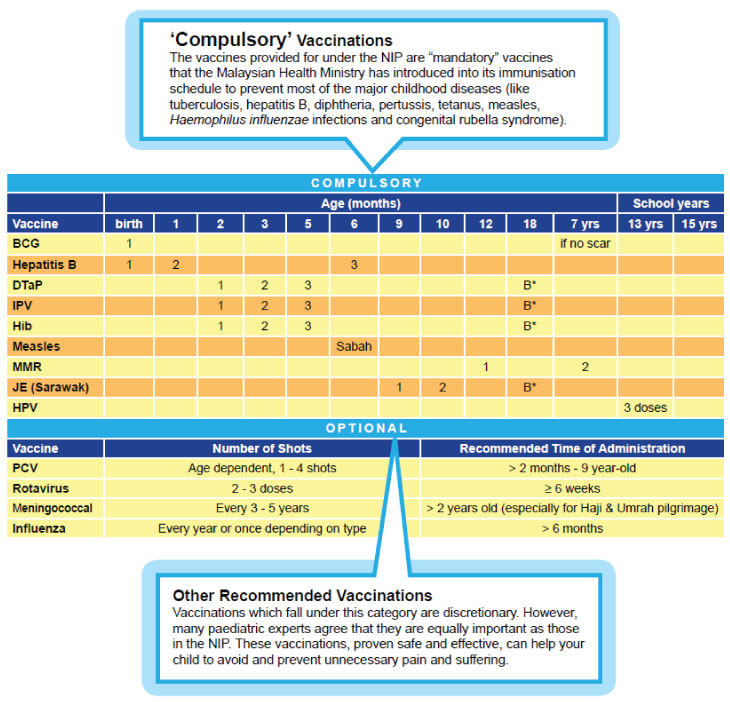
Consider pneumonia, a prevailing disease affecting between 28 – 39% of children under the age of 5 and is the fourth highest cause of child death in Malaysia. Despite high risk of possible infection, many parents do not bother to vaccinate against it. Similarly regrettable is the fact that the pneumococcal conjugate vaccine (PCV) has yet to be adopted into the NIP. Nevertheless, if you are interested, you can get your child vaccinated with these other recommended optional vaccines at any private healthcare facility which readily provides them. Consult your paediatrician for recommendations or advice.
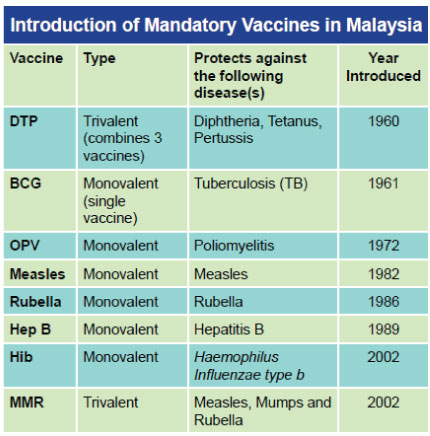
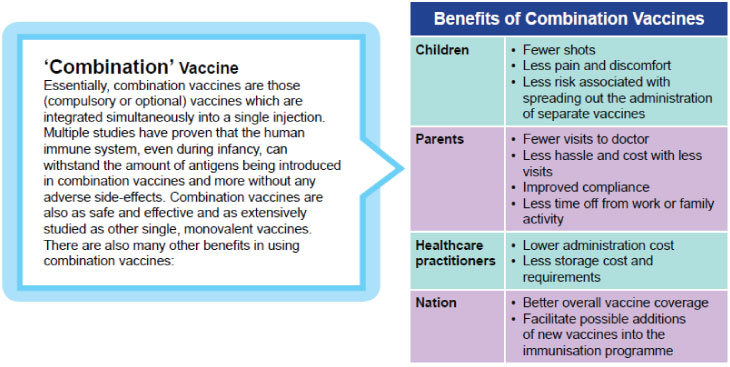
New Vaccines: Dengue
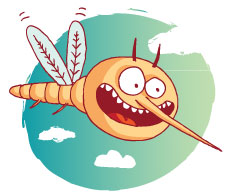
Malaysia has long been drowning in cases carried by mosquitoes and dengue has been quite problematic whilst children have been the most predominant group affected. Although there is no licensed dengue vaccine available in the market, there are those currently being developed. The WHO in July published a statement saying that the vaccine candidate currently at the most advanced clinical development stage is a live attenuated tetravalent dengue vaccine developed by Sanofi Pasteur (CYDTDV), which is under evaluation in phase III clinical studies. If all goes well, we can expect a commercially available batch within a few more years.

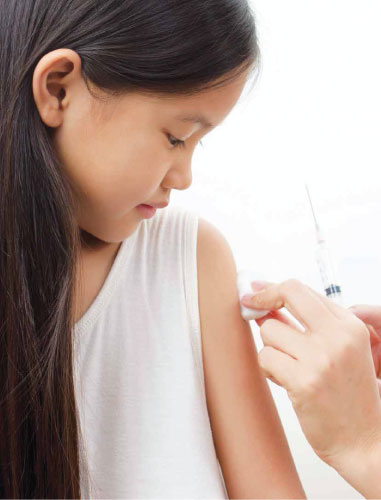




Comments